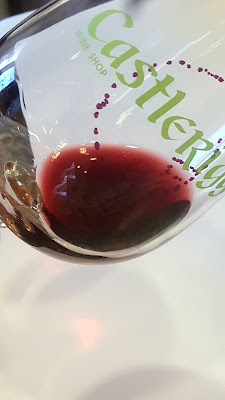 |
| Source: decanter.com |
It's a big fruit- and vegetable-growing area, and also a privileged wine region, which in Spanish is called "Denominacion de Origen Calificada" (compare to French Appellation d'origine controlee, American AVA markings, and Italian Denominazione di Origine Controllata). Furthermore, to be considered Rioja, grapes must be grown in one of three subregions - Rioja Alavesa, Rioja Baja, and Rioja Alta. According to Rioja's wine control board, there are around 600 wineries in the region.
Today's wine, a 2012 example from winery Vina Bujanda, is from Oyon, and is further classified as Rioja Alavesa. Of the four Rioja quality classifications, this is second - Crianza. Rioja's wine control board marks 2012 as a "very good year." a term you may hear thrown about often. This just means growing conditions and a host of other man-made and environmental factors contributed to a good growth season in line with the requirements of the grapes. You can read the full report here.
The wine is 100% tempranillo, a grape I have had many many times in the past, so I have some idea of what to expect. Tempranillo is often blended, but does appear by itself frequently.
Let's give it a shot. It's dark red when poured, and garnet-colored and clear when candled.
Yep, it's definitely tempranillo. It's fresh, light, with soft cherry and red ripe fruit flavors. I'm particularly enjoying the clean and fruity flavors throughout with lots of fructose. It's not tannic at all, what wine tasters may call "soft" or "supple". The finish is clean and swift, and there's a slight zing of alcohol on the aftertaste but nothing to complain about.
Very tasty wine. I'm more partial to French reds, so I enjoy the jammy brightness that tempranillo generally possesses. That being said, I'd be curious to see what more expensive Rioja was like. At $22, this isn't cheap by any means, but there are two higher "levels" of Rioja - Reserva and Gran Reserva, both assumedly more expensive and rare. According to winefolly.com, these upper levels of Rioja simply change the number of years the wine spends in oak and in the bottle. By extension, this would change the flavor profile of the wine, making it softer and perhaps less sweet.
Regarding food - good pairings are Spanish omelette (a classic, really) light meats, rice, and paella, I paired it with a roasted beef tenderloin served with yams and mashed potatoes. The soft fruitiness of the wine was a nice complement to the delicate seasonings of the meat. A nice pairing and a nice bottle!




























